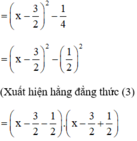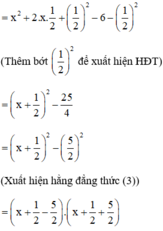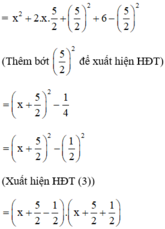(x2+x)2-(x2+x)-6. Phân tích thành nhân tử
Hãy nhập câu hỏi của bạn vào đây, nếu là tài khoản VIP, bạn sẽ được ưu tiên trả lời.


Cách 1: Tách một hạng tử thành tổng hai hạng tử để xuất hiện nhân tử chung.
a) x2 – 3x + 2
= x2 – x – 2x + 2 (Tách –3x = – x – 2x)
= (x2 – x) – (2x – 2)
= x(x – 1) – 2(x – 1) (Có x – 1 là nhân tử chung)
= (x – 1)(x – 2)
Hoặc: x2 – 3x + 2
= x2 – 3x – 4 + 6 (Tách 2 = – 4 + 6)
= x2 – 4 – 3x + 6
= (x2 – 22) – 3(x – 2)
= (x – 2)(x + 2) – 3.(x – 2) (Xuất hiện nhân tử chung x – 2)
= (x – 2)(x + 2 – 3) = (x – 2)(x – 1)
b) x2 + x – 6
= x2 + 3x – 2x – 6 (Tách x = 3x – 2x)
= x(x + 3) – 2(x + 3) (có x + 3 là nhân tử chung)
= (x + 3)(x – 2)
c) x2 + 5x + 6 (Tách 5x = 2x + 3x)
= x2 + 2x + 3x + 6
= x(x + 2) + 3(x + 2) (Có x + 2 là nhân tử chung)
= (x + 2)(x + 3)
Cách 2: Đưa về hằng đẳng thức (1) hoặc (2)
a) x2 – 3x + 2

(Vì có x2 và  nên ta thêm bớt
nên ta thêm bớt  để xuất hiện HĐT)
để xuất hiện HĐT)

= (x – 2)(x – 1)
b) x2 + x - 6

= (x – 2)(x + 3).
c) x2 + 5x + 6

= (x + 2)(x + 3).

\(1,\\ 12x^6y^3:4x^3y=3x^3y^2\\ \left(x+1\right)\left(x^2-x+1\right)=x^3+1\\ 2x^2y\left(x^2+3xy\right)=3x^4y+6x^3y^2\\ 2,\\ a,=2xy\left(2x+3y-4\right)\\ b,=\left(x-3\right)\left(x+y\right)\\ c,=\left(x-2\right)\left(x+2\right)+y\left(x-2\right)=\left(x+y+2\right)\left(x-2\right)\\ d,=x^2-2x-5x+10=\left(x-2\right)\left(x-5\right)\\ 3,\\ a,\Leftrightarrow x^2-x^2+2x=2\\ \Leftrightarrow2x=2\Leftrightarrow x=1\\ b,\Leftrightarrow\left(x-2\right)\left(x-2+1\right)=0\\ \Leftrightarrow\left(x-2\right)\left(x-1\right)=0\Leftrightarrow\left[{}\begin{matrix}x=1\\x=2\end{matrix}\right.\)

a ) x 2 - 3 = x 2 - ( √ 3 ) 2 = ( x - √ 3 ) ( x + √ 3 ) b ) x 2 - 6 = x 2 - ( √ 6 ) 2 = ( x - √ 6 ) ( x + √ 6 ) c ) x 2 + 2 √ 3 x + 3 = x 2 + 2 √ 3 x + ( √ 3 ) 2 = ( x + √ 3 ) 2 d ) x 2 - 2 √ 5 x + 5 = x 2 - 2 √ 5 x + ( √ 5 ) 2 = ( x - √ 5 ) 2

x 2 + 5 x – 6 = x 2 – x + 6 x – 6 = ( x 2 – x ) + 6( x – 1)
= x ( x – 1) + 6( x – 1) = ( x – 1)( x + 6)

a) \(x^2-5=\left(x-\sqrt{5}\right)\left(x+\sqrt{5}\right)\)
b) \(x^2-11=\left(x-\sqrt{11}\right)\left(x+\sqrt{11}\right)\)
c: \(x-2=\left(\sqrt{x}-2\right)\left(\sqrt{x}+2\right)\)
d: \(x^2-2\sqrt{5x}+5=\left(x-\sqrt{5}\right)^2\)

1)
a) \(=3x^2\left(x^2-1\right)-\left(x^3-1\right)+x^8-3x^4+3x^2-1\)
\(=3x^4-3x^2-x^3+1+x^8-3x^4+3x^2-1=x^8-x^3\)
2)
\(=\left(x^2+5x-6\right)\left(x^2+5x+6\right)-6\left(x^2+5x\right)+45\)
\(=\left(x^2+5x\right)^2-6\left(x^2+5x\right)-36+45\)
\(=\left(x^2+5x\right)^2-6\left(x^2+5x\right)+9=\left(x^2+5x-3\right)^2\)

x2 – x – 6
= x2 + 2x – 3x – 6
(Tách –x = 2x – 3x)
= x(x + 2) – 3(x + 2)
(có x + 2 là nhân tử chung)
= (x – 3)(x + 2)

-Đặt \(t=\left(x^2-x+1\right)\)
\(\left(x^2-x+1\right)^2-5x\left(x^2-x+1\right)+4x^2\)
\(=t^2-5xt+4x^2\)
\(=t^2-4xt-xt+4x^2\)
\(=t\left(t-4x\right)-x\left(t-4x\right)\)
\(=\left(t-4x\right)\left(t-x\right)\)
\(=\left(x^2-x+1-4x\right)\left(x^2-x+1-x\right)\)
\(=\left(x^2-5x+1\right)\left(x^2-2x +1\right)\)
\(=\left(x^2-5x+1\right)\left(x-1\right)^2\)

\(\left(x^2+x\right)^2-\left(x^2+x\right)-6=x^4+2x^3+x^2-x^2-x-6\)
\(=x^4+2x^3-x-6\)
\(=x^4+x^3+2x^2+x^3 +x^2+2x-3x^2-3x-6\)
\(=\left(x^4+x^3+2x^2\right)+\left(x^3+x^2+2x\right)-\left(3x^2+3x+6\right)\)
\(=x^2\left(x^2+x+2\right)+x\left(x^2+x+2\right)-3\left(x^2+x+2\right)\)
\(=\left(x^2+x+2\right)\left(x^2+x-3\right)\)